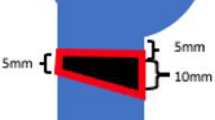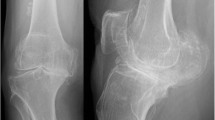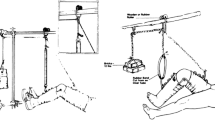Abstract
We evaluated the outcome in 10 young patients, ages ranging from 15 to 26, with types III and IV osteochondritis dissecans of the knee, treated with Herbert screws fixation and reverse guided drillings. The disease involved the medial femoral condyle in eight patients and the lateral in two. Diagnosis and preoperative planning based on plain radiographs (AP, lateral and tunnel view) and MRI (in seven patients). Fixation of the fragment with Herbert screws using a mini-arthrotomy technique and additional reverse drillings behind the crater of the lesion using the ACL aiming devise were performed in all patients. Post-operatively, no weight bearing was recommended for at least three months. The follow-up ranged from 15 months to 38 months (mean 27 months). According to the subjective questionnaire of the International Cartilage Repair Society (ICRS) scale, seven patients had normal knees, two had nearly normal knees and one abnormal. The Lysholm Knee score ranged 65–96 points (mean 88 points). All patients except one returned to their previous activities and they were satisfied with the result. Radiological union of the fragment was found in 9/10 patients (six grade III, three grade IV). Progressive flattening of the injured femoral condyle was noticed in two patients (grade III). Securing the lesion using Herbert screws in combination with reverse guided drillings seems to be an effective treatment choice for detached or displaced osteochondral fragments.




Similar content being viewed by others
References
Aglietti P, Buzzi R, Bass PB, Frioriti M (1994) Arthroscopic drilling in juvenile osteochondritis dissecans of the medial femoral condyle. Arthroscopy 10:286–291
Aglietti P, Ciardullo A, Giron F, Ponteggia F (2001) Results of arthroscopic excision of the fragment in the treatment of osteochondritis dissecans of the knee. J Arthrosc Rel Surg 7:741–746
Anderson AF, Lipscomb AB, Coulam C (1990) Antegrade curettement, bone grafting and pinning of osteochondritis dissecans in the skeletally mature knee. Am J Sports Med 18:254–261
Cahill BR (1995) Osteochondritis dissecans of the knee: treatment of juvenile and adult forms. J Am Acad Orthop Surg 3:237–247
Cahill BR, Berg BC (1983) 99m-Technetium phosphate compound joint scintigraphy in the management of juvenile osteochondritis dissecans of the femoral condyles. Am J Sports Med 11:329–335
Clanton TO, DeLee JC (1982) Osteochondritis dissecans: history, pathophysiology and current treatment concepts. Clin Orthop 167:50–64
Dervin G, Keene G, Chissell H (1998) Biodegradable rods in adult osteochondritis dissecans of the knee. Clin Orthop 356:213–221
Greville NR (1964) Osteochondritis dissecans: treatment by bone grafting. Southern Med J 57:886–893
Jaberi FM (2002) Osteochondritis dissecans of the weight-bearing surface of the medial femoral condyle in adults. Knee 9(3):201–207
Jakob R, Miniaci A (1989) A compression pinning system for osteochondritis dissecans of the knee. Acta Orthop Scand 60(3):319–321
Jonson LL, Uitvlugt G, Austin MD, Detrisac DA, Johnson (1990) Osteochondritis dissecans of the knee: arthroscopic compression screw fixation. Arthroscopy 6:179–189
Jurgensen I, Bachmann G, Schleicher I, Haas H (2002) Arthroscopic versus conservative treatment of osteochondritis dissecans of the knee: value of magnetic resonance imaging in therapy planning and follow-up. Arthroscopy 18(4):378–386
Kivisto R, Pasanen L, Leppilahti, Jalovaara P (2002) Arthroscopic repair of osteochondritis dissecans of the femoral condyles with metal staple fixation: a report of 28 cases. Knee Surg Sports Traumatol Arthrosc 10:305–309
Lindholm TS, Osterman K (1980) Long term results after transfixation of an osteochondritis dissecans fragment to the femoral condyle using autologous bone transplants in adolescent and adult patients. Arch Orthop Trauma Surg 97:225–230
Lipscomb PR Jr, Lipscomb PR Sr, Bryan RS (1978) Osteochondritis dissecans of the knee with loose fragments. Treatment by replacement and fixation with readily removed pins. J Bone Joint Surg 60:235–240
Louisia S, Beaufils P, Katabi M, Robert H (2003) Transchondral drilling for osteochondritis dissecans of the medial condyle of the knee. Knee Surg Sports Traumatol Arthrosc 11(1):33–39
Mackie IG, Pemberton DJ, Maheson M (1990) Arthroscopic use of the Herbert screw in osteochondritis dissecans. J Bone Joint Surg 72(6):1076
Rey Zuniga JJ, Sagastibelza J, Lopez Blasco JJ, Martinez Grande M (1993) Arthroscopic use of the Herbert screw in osteochondritis dissecans of the knee. Arthroscopy 9(6):668–670
Slough J, Noto A, Schmidt T (1989) Tibial cortical bone peg fixation in osteochondritis dissecans of the knee. Clin Orthop 267:122–127
Smillie IS (1957) Treatment of osteochondritis dissecans. J Bone Joint Surg 39(2):248–260
Thomson NL (1987) Osteochondritis dissecans and osteochondral fragments managed by Herbert compression screw fixation. Clin Orthop 224:71–78
Wombwell JH, Nunley JA (1987) Compressive fixation of osteochondritis dissecans fragments with Herbert screws. J Orthop Trauma 1:74–77
Author information
Authors and Affiliations
Corresponding author
Rights and permissions
About this article
Cite this article
Kouzelis, A., Plessas, S., Papadopoulos, A.X. et al. Herbert screw fixation and reverse guided drillings, for treatment of types III and IV osteochondritis dissecans. Knee Surg Sports Traumatol Arthrosc 14, 70–75 (2006). https://doi.org/10.1007/s00167-005-0634-9
Received:
Accepted:
Published:
Issue Date:
DOI: https://doi.org/10.1007/s00167-005-0634-9




